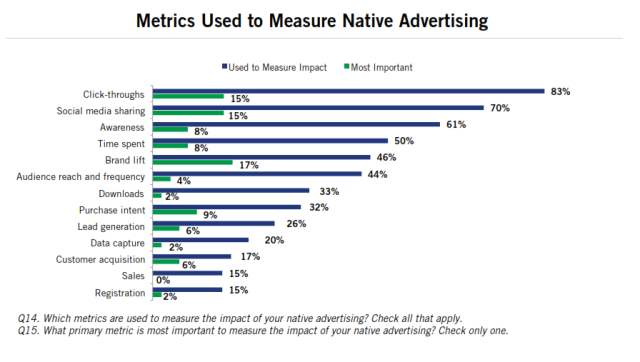
Marketers lack a single most important metric for measuring native advertising. Chart courtesy of the Association of National Advertisers
Native advertising is clearly a winning strategy for both publishers and brands.
Marketers find that paid advertising content designed to blend with website editorial content often attracts more readers and gains greater engagement. Publishers have discovered that native ads, also known as sponsored content, can provide healthy revenue income.
Out of 127 marketers surveyed by the Association of National Advertisers, 55 percent said their native advertising budgets increased last year and 63 percent expected those budgets to increase this year.
However, marketers find that measuring native advertising is challenging. The ANA warns that a lack of standardardized metrics could impede further growth of the promising channel. Marketers track a range of metrics. No single metric stands out as most important.
Seeking a Deeper Understanding of Metrics
“For all the buzz around native advertising, you don’t hear a lot about measurement and ROI,” Bill Duggan, ANA executive vice president, told The Wall Street Journal. “The industry would benefit from a deeper understanding of the metrics that matter most for native.”
Setting an industry standard may prove difficult considering brands seek different objectives that may call for different metrics.
Nine percent of marketers surveyed said measurement issues are a barrier to initiating native advertising. No metric stood out when marketers were asked to pick a single most important metric: 17 percent named “brand lift,” but 15 percent cited click-throughs and social media sharing.
The click-through rate is the popular metric, used by 83 percent, followed by social media sharing and awareness.
Beyond Publisher Metrics
Although many publishers and advertisers examine engagement and click-through rates, those metrics have drawbacks, says Steve Wick, founder and president of MobSoc Media. Engagement does not always provide an immediate and measurable increase in sales or conversions, he writes in an article for AdExchanger.
Marketers can start with metrics publishers provide such as page views, but those metrics aren’t the only way to track performance.
Using trackable links in native ads enables you to measure the number of visitors following links from the ads to your own website. That lets you to track how many new sales prospects come from which native ads and helps you gain some control over getting new customers into the sales pipeline.
Brands can also configure Google Analytics or another web analytics tool to measure whether the traffic driven to the landing page is fulfilling specific campaign objectives.
How Publishers Measure Native Ads
When Digiday asked publishers how they gauge native ad performance it received a variety of answers. Mashable prefers engagement (whether the content is on its site or off it) such as the percentage of readers who share it from Facebook.
Sporting News called click-through rates “a Stone Age metric.” Page views, the amount of time people spend on a page, and engagement levels are far more meaningful.
Forbes strives to treat advertises like publishers. Forbes give brands the same dashboards as its staff members and contributors that let them view page views and other figures. Another dashboard provides their social metrics.
Bottom Line: Native advertising is a promising avenue for promoting brands’ content. However, measuring the success of sponsored content can be problematic. Publishers and marketers prefer different metrics and they lack an industry measurement standard. The missing measurement standards could obstruct the growth of native advertising.
William J. Comcowich founded and served as CEO of CyberAlert LLC, the predecessor of Glean.info. He is currently serving as Interim CEO and member of the Board of Directors. Glean.info provides customized media monitoring, media measurement and analytics solutions across all types of traditional and social media.




